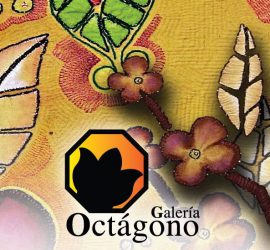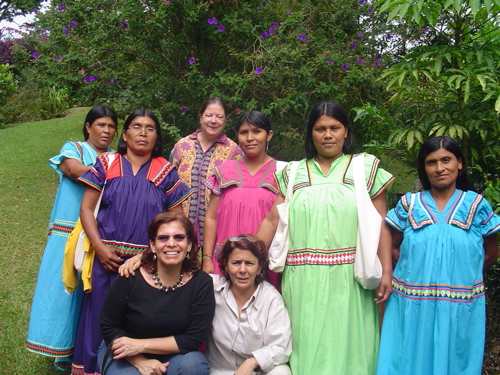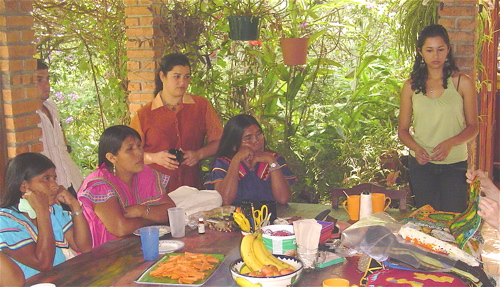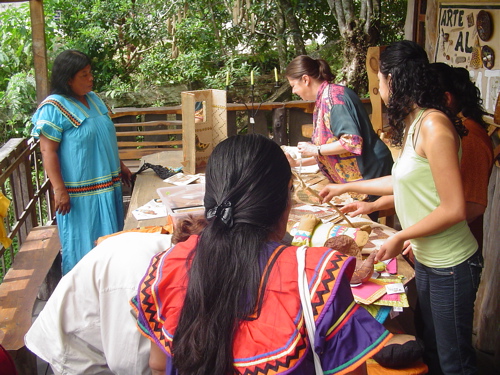Hace un año, el Instituto Nacional de las Mujeres (INAMU) de Costa Rica http://www.inamu.go.cr/
contrató a mis amigas artistas costarricenses Ana Isabel Barrientos (artista visual con especialidad en diseño) y Adriana Ramírez (artista textil especializada en desarrollo Indígena sostenible), para que ofrecieran una capacitación a cinco pueblos Indígenas Ngöbe-Guaymí de la zona sur del país.
Como parte de esta capacitación, han llevado sus piezas a exhibición y venta, para así entrenarse en destrezas de mercadeo. Hoy, cinco de ellas visitaron la Galería Octágono, acompañadas de sus instructoras y una representante del INAMU.
Esta visita fue un encuentro sumamente importante desde el punto de vista textil, pues el grupo de ellas y mi grupo (Colectiva de Mujeres Cerro Danta), compararon notas en cuanto a diseños y técnicas utilizadas, ampliando horizontes y alimentándose mutuamente de la creatividadad de cada quien. Pero igualmente importante ha sido el aspecto humano, pues en nuestra provincia de Heredia donde vivimos —al norte de la ciudad capital de San José— se acostumbra observar mujeres Guaymí pidiendo limosna, lo cual inspira un sentimiento general de lástima. Hoy, sin embargo, tanto nosotras como los dos niños de mi Colectiva que pudieron acompañarnos, nos deleitamos viendo y comprando tapices bordados en mastate, bolsos tejidos con los dedos usando camisetas (remeras) desechadas, e innumerables muñecos y animales de tela y de mastate, todo exquisitamente bordado y decorado.
El mastate es una fibra que estas mujeres sacan de la corteza de ciertos árboles del género Castilla, procesada hasta convertirla en una especie de membrana, la cual bordan y pintan con tintes naturales. Estas telas de corteza son comúnmente usadas en todo el ámbito de las Américas equinocciales donde crecen árboles dicotiledoneos diversos (mientras que al sur de la línea ecuatorial y al norte del Trópico de Cáncer son más usados los tejidos de lana animal).
Muchos de los pueblos Guaymí provienen de Panamá y poco a poco se han asentado en lugares remotos e inhóspitos al sur de Costa Rica, donde a veces sufren de pobreza extrema debido a a la falta de comunicación geográfica con el resto de la región.
El proceso de capacitación que Ana y Adriana tuvieron que implementar es sumamente interesante y complejo, comprendiendo desde el aprendizaje de conceptos básicos sobre color, pintura y formato, hasta la buena presentación del trabajo.
A year ago, the National Institute for Women (INAMU) http://www.inamu.go.cr/ in Costa Rica, hired my friends and artists, Ana Isabel Barrientos (visual artist specialized in design), and Adriana Ramírez (textile artist specialized in sustainable Indigenous development), to offer training to five Indigenous Ngöbe-Guaymí groups in the southern part of the country.
As part of this training they have taken their pieces to exhibition and sale in order to develop marketing skills. Today, five of them paid a visit to Galería Octágono along with their instructors and a representative from INAMU.
This visit was a very important encounter from the textile point of view, because their group and my group (Cerro Danta Women’s Collective), compared notes with respect to designs and techniques utilized, thereby broadening horizons and feeding on each other’s creativity. But equally important was the human aspect since in our province of Heredia—where we live, north of the capital city of San José—we can see some Guaymí women begging, which generally inspires pity. This time, however, we and the two children that where present really enjoyed admiring and buying tapestries embroidered over mastate, bags woven with their fingers using discarded T-shirt material, and an assortment of dolls and animals in fabric and mastate—all exquisitely embroidered and embellished.
Mastate is a fiber that women make out of the bark of certain trees of the genus Castilla, processed to turn it into a membrane, which they embroider and paint with natural dyes. These bark cloths are commonly used throughout the equinoctial Americas, where diverse dicotyledon trees can be found (as opposed to locations south of the equator, or north of the Tropic of Cancer where animal wool knits are more commonly found.)

Many Guaymí groups come from Panama, and have settled little by little in remote and/or inhospitable areas in the Costa Rican south, where they sometimes endure extreme poverty due to lack of geographic communication with the rest of the region.
The training process Ana and Adriana had to implement is very interest and complex, comprising everything from basic concepts about color, paint, and format, to good work presentation.









